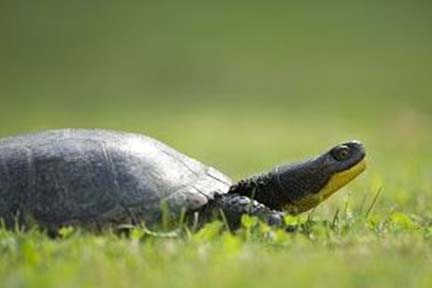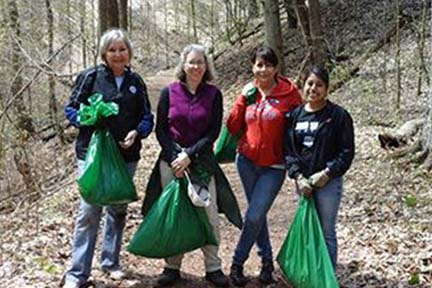July 28, 2021
Contact: Michelle Zellar, 906-293-5131 ext. 4004 or John Pepin, 906-226-1352
Registration opens for fall Becoming an Outdoors-Woman program in the Upper Peninsula
The Michigan Department of Natural Resources announced today registration is open for its Becoming an Outdoors-Woman program, which is set for Sept. 10-12 in Marquette County.
This will mark the first-ever Michigan BOW fall gathering for women, 18 and older, who are seeking an opportunity to improve their outdoor skills in a relaxed, noncompetitive atmosphere. The traditional February and June gatherings were cancelled earlier this year because of coronavirus precautions.
“Becoming an Outdoors-Woman is a program where each individual is encouraged to learn at her own pace,” said Michelle Zellar, BOW program coordinator in Newberry. “The emphasis is on the enjoyment, fun and camaraderie of outdoor activities and sharing in the success of one another.”
The fall BOW program is sponsored by the DNR and offers instruction in more than 20 different types of activities, including kayaking, wilderness survival, lake and fly fishing, rock climbing, geocaching, shooting sports, hammock camping, basic land navigation and introduction to turkey hunting.
“Volunteer BOW instructors provide basic and advanced teaching that is tailored to each participant’s individual ability, helping participants learn the basics in a short amount of time,” Zellar said.
Please take the BOW Participation Survey to provide important information that will help shape future BOW gatherings.
BOW participants in the fall program will stay and take their classes at the UP-Bible Camp, a universally accessible facility overlooking Farmers Lake, which is situated about 20 miles south of Marquette, near Gwinn.
Participants will be housed in a dorm-style facility with amenities, including a sauna, basketball courts, high ropes course, zipline, hiking and biking trails, along with easy access to a beautiful, forested area.
Registration enrollment will be limited to fewer attendees than our traditional summer event which typically hosts over a hundred participants.
“All of our programs typically fill quickly, so early registration is encouraged,” Zellar said.
The $225 registration fee includes all food and lodging, as well as most equipment and supplies. The deadline for registration is Aug. 15, 2021. A limited number of partial BOW scholarships are available to help low-income participants with the cost of registration. The scholarship application deadline is Aug. 6, 2021.
Class information and registration materials are available online at Michigan.gov/BOW. Registrations must be mailed, with payment, to the Newberry Customer Service Center stated on the form.
For more information on the fall BOW program, contact Michelle Zellar at the DNR Customer Service Center in Newberry at 906-293-5131 ext. 4004, or by e-mail at [email protected]. |



 Off-roaders, get ready! The Michigan Department of Natural Resources is hosting its second and final Free ORV Weekend of the year, Aug. 21-22.
Off-roaders, get ready! The Michigan Department of Natural Resources is hosting its second and final Free ORV Weekend of the year, Aug. 21-22.


 Want to see more pictures like this, taken by Michigan state parks photo ambassador
Want to see more pictures like this, taken by Michigan state parks photo ambassador  We’re pleased to announce the winners of the Consumers Energy-sponsored Explore MI Wetland Wonders contest. All four winners will receive Cabela’s gift cards in varying amounts:
We’re pleased to announce the winners of the Consumers Energy-sponsored Explore MI Wetland Wonders contest. All four winners will receive Cabela’s gift cards in varying amounts:
 Imagine what the summer heat would feel like without the cooling shade of backyard trees. If you appreciate your trees, August is the time to show them some love! Take a few minutes to check your trees for invasive Asian longhorned beetles and the damage their larvae leave behind.
Imagine what the summer heat would feel like without the cooling shade of backyard trees. If you appreciate your trees, August is the time to show them some love! Take a few minutes to check your trees for invasive Asian longhorned beetles and the damage their larvae leave behind.
 We’re coming into what traditionally is the hottest part of Michigan summer, and that means many people are flocking to the water for relief and relaxation. Whether plans include time on the Great Lakes or inland lakes and waterways, a little preparation will go a long way toward ensuring everyone in your group has a great time and stays safe.
We’re coming into what traditionally is the hottest part of Michigan summer, and that means many people are flocking to the water for relief and relaxation. Whether plans include time on the Great Lakes or inland lakes and waterways, a little preparation will go a long way toward ensuring everyone in your group has a great time and stays safe.
 A new exhibit at the DNR’s Michigan History Museum in Lansing shares the history of voting rights in Michigan and showcases stories about the people, protests and policies that transformed voting in our state.
A new exhibit at the DNR’s Michigan History Museum in Lansing shares the history of voting rights in Michigan and showcases stories about the people, protests and policies that transformed voting in our state.

 From Iron Mountain in the western Upper Peninsula to the village of Dundee in the state’s southeast corner, 26 communities across Michigan will share $92,500 in grants this year to plant trees.
From Iron Mountain in the western Upper Peninsula to the village of Dundee in the state’s southeast corner, 26 communities across Michigan will share $92,500 in grants this year to plant trees.


 Want to see more pictures like this, taken by Michigan state parks photo ambassador
Want to see more pictures like this, taken by Michigan state parks photo ambassador  You may have noticed over your morning cup of coffee or tea that more birds are flitting from tree to flower to ground in search of food and water. It also might strike you how quiet these birds are compared to the morning chorus common in May and June.
You may have noticed over your morning cup of coffee or tea that more birds are flitting from tree to flower to ground in search of food and water. It also might strike you how quiet these birds are compared to the morning chorus common in May and June.
 On the way to school, the park or a city walking trail, take a look around. Could your local trees benefit from increased maintenance, planning or management technology? Or maybe outreach and education could help share the importance of trees with the next generation. If you’re interested in helping to green your community, connect with your local municipal office, campus administration or other planning authority to share the Community Forestry grant opportunity, administered by the DNR.
On the way to school, the park or a city walking trail, take a look around. Could your local trees benefit from increased maintenance, planning or management technology? Or maybe outreach and education could help share the importance of trees with the next generation. If you’re interested in helping to green your community, connect with your local municipal office, campus administration or other planning authority to share the Community Forestry grant opportunity, administered by the DNR.
 Community scientists throughout the state stepped up and answered the call for rare-turtle observation reports this spring, submitting over 200 confirmed reports of Blanding’s turtles (pictured) – a species of special concern in Michigan. Additionally, the U.S. Fish and Wildlife Service is evaluating whether the status of Blanding’s turtle warrants listing as a federally endangered or threatened species.
Community scientists throughout the state stepped up and answered the call for rare-turtle observation reports this spring, submitting over 200 confirmed reports of Blanding’s turtles (pictured) – a species of special concern in Michigan. Additionally, the U.S. Fish and Wildlife Service is evaluating whether the status of Blanding’s turtle warrants listing as a federally endangered or threatened species.
 Ready to ride where there’s plenty of woods and no pavement to be seen? State forest roads are your gateway to outdoor adventure.
Ready to ride where there’s plenty of woods and no pavement to be seen? State forest roads are your gateway to outdoor adventure.


 Several state parks in southern Michigan will host volunteer stewardship workdays in August. Volunteers are needed to help with removing invasive plants that threaten high-quality ecosystems in the parks.
Several state parks in southern Michigan will host volunteer stewardship workdays in August. Volunteers are needed to help with removing invasive plants that threaten high-quality ecosystems in the parks.
 The DNR responsibly manages 3.9 million acres of state forest land using such techniques as timber harvests, planting and prescribed burns to keep forests thriving and healthy.
The DNR responsibly manages 3.9 million acres of state forest land using such techniques as timber harvests, planting and prescribed burns to keep forests thriving and healthy.
 Staff recommendations on whether to keep, exchange or sell land in the second set of 10 counties in the DNR’s state land review process are nearing DNR director approval, but there’s still plenty of time to review and share feedback via the
Staff recommendations on whether to keep, exchange or sell land in the second set of 10 counties in the DNR’s state land review process are nearing DNR director approval, but there’s still plenty of time to review and share feedback via the  Community science – or community members collecting data and observations – helps researchers and natural resource managers learn more about wildlife, invasive species, water quality, the effects of climate change and much more.
Community science – or community members collecting data and observations – helps researchers and natural resource managers learn more about wildlife, invasive species, water quality, the effects of climate change and much more.
